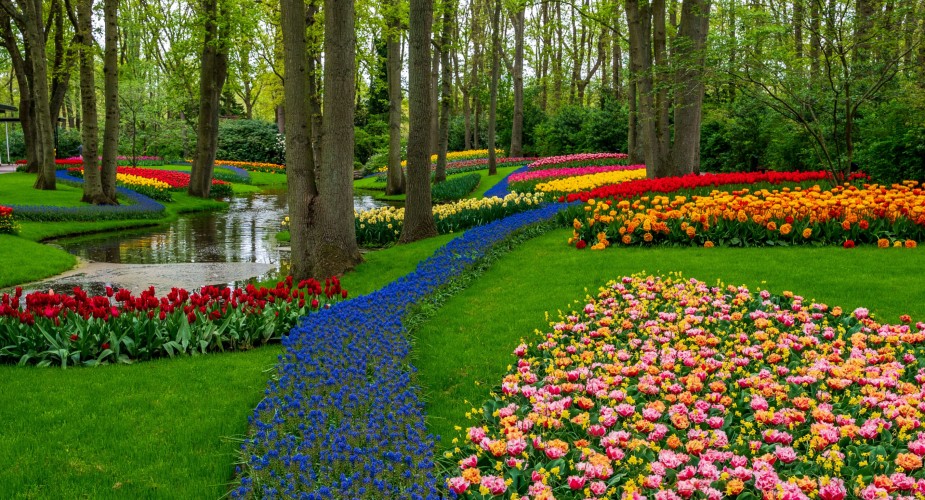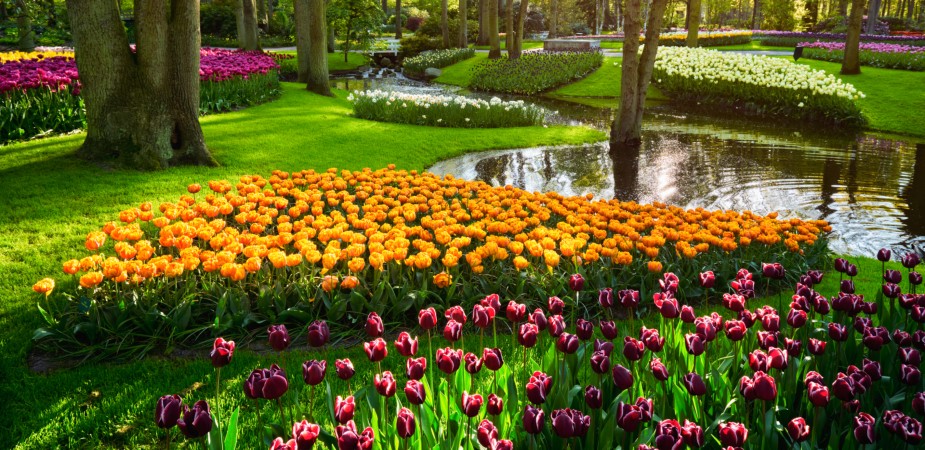Have you ever wondered how Keukenhof became the world’s most famous spring garden? Every year, over 1.5 million visitors see its exquisite display of tulips, daffodils, and hyacinths, but few know the rich history behind this floral wonderland.
Keukenhof wasn’t always a tourist attraction. It started as a 15th-century hunting ground and herb garden for a countess. Over time, it transformed into a global symbol of Dutch horticulture. This article will tell you everything about the origins of Keukenhof, the magic behind its beautiful garden designs, and why you should visit this place at least once.
The Origins of Keukenhof: From Royal Hunting Grounds to Garden Paradise

Keukenhof was once part of the hunting grounds surrounding Teylingen Castle, a medieval fortress near modern-day Lisse. In the 15th century, Countess Jacqueline of Bavaria used this vast area for growing herbs, fruits, and vegetables for the castle’s kitchens and as a place for hunting game, a common pastime for European nobility.
Teylingen Castle was an important noble residence, and the surrounding forests and dunes were ideal for hunting deer, boar, and other wildlife. Nobles and aristocrats often maintained large estates with designated hunting areas meant to represent wealth, power, and control over the land.
In the late 1630s, the ownership of the land changed, and a governor of the Dutch East India Company purchased it. He commissioned the construction of Keukenhof Castle (Kasteel
Keukenhof) in 1641, and over time, the estate grew to cover more than 200 hectares (nearly 500 acres).
The most significant transformation came in the mid-1800s when famous landscape architects Jan David Zocher and his son Louis Paul Zocher transformed the castle’s gardens in English. What once served as hunting grounds and a source of fresh produce for a medieval castle became a majestic garden estate, setting the stage for its future as the world’s most famous flower garden.
The Magic Behind Keukenhof’s Garden Designs

As mentioned earlier, the famous landscape architects Jan David Zocher and his son Louis Paul Zocher transformed the castle’s gardens in the English landscape style in the mid-1800s. This style is all about creating a natural flow, blending the gardens with the surrounding landscape. It’s very different from the neat, symmetrical gardens that were popular then.
One of the most striking features of the design is how it invites you to wander. The meandering pathways encourage visitors to explore, guiding you through various garden sections at your own pace. There are also several water features, like canals and ponds, paired with tree clusters, creating a peaceful and almost magical atmosphere.
The true magic of Keukenhof, however, emerges in the spring. Every year, the garden explodes with color as thousands of tulips, daffodils, hyacinths, and other flowers bloom in meticulously arranged beds. But it’s not just the main flowerbeds that make Keukenhof unique. The garden also has pavilions and theme gardens, such as the exquisite lily garden or the tropical orchid display. The design principles set in motion by the Zochers are still felt today, making Keukenhof not just a garden but a living work of art.
The Flower Shows That Made Keukenhof Famous

Keukenhof Gardens, the Garden of Europe, is famous for one of the world’s most spectacular flower festivals. This festival, also known as the Spring Festival, is held annually in Lisse, Netherlands. It features beautiful displays of tulips, daffodils, hyacinths, and many other flowers, all of which have contributed to the history of Keukenhof Gardens.
Every year, the gardeners at Keukenhof team up with over 100 flower companies, planting around 7 million bulbs to create what they call a ‘living catalog.’ The flowers bloom in fields, and the garden has beautiful arrangements, sculptures, and pavilions.
The real beauty of the festival lies in the flower shows. In 20 distinct shows, about 500 flower growers display their finest collections of flowers that they have contributed. These shows are spread out across the 79-acre estate, and this tradition of flower shows is a big reason why this garden is so famous.
Indoor Flower Shows at Keukenhof Gardens 2025
After reading about the flower shows, you might wonder when you can see these beautiful displays. Check out the table below for the latest indoor flower shows at Keukenhof Gardens in 2025:
| Keukenhof Indoor Flower Shows | Date |
|---|---|
| Tulip and Hyacinth show | 20 March to 25 March |
| Anthurium and Orchid show | 20 March to 11 May |
| Freesia and Chrysanthemum show | 27 March to 1 April |
| Rose show | 3 April to 8 April |
| Daffodil and Special Bulbs show | 10 April to 15 April |
| Alstroemeria and Calla show | 17 April to 22 April |
| Gerbera, Lisianthus and Calla show | 24 April to 29 April |
| Carnation and Summer’s flowers show | 1 May to 11 May |
Why You Should Visit Keukenhof at Least Once
If you love nature and flowers or simply want to experience one of the most beautiful places on Earth, visiting Keukenhof Gardens should be at the top of your bucket list. The history of Keukenhof Gardens stretches back to the 15th century, from its humble beginnings as a royal herb garden to becoming one of the most famous flower festivals in the world. The experience of walking through the vibrant fields of 7+ million tulips, daffodils, hyacinths, and more is something that can’t be found anywhere else.
You can even snap a selfie with a rainbow of flowers around you! And the best part? You don’t have to wait long to enjoy the beauty of Keukenhof! With tickets readily available, you can plan your visit and see the garden bloom this spring. Get your Keukenhof tickets early, as the garden can get quite busy during peak season (mid-April to early May).
Fun Facts and Traditions at Keukenhof!
- The Keukenhof tulip holds a world record for being one of the largest collections of tulips in the world.
- Every year, the Keukenhof Flower Festival has a special theme, which influences the design and color schemes of the garden displays.
- In just one year, Keukenhof uses more than 2 million tulip bulbs in its displays alone!
- Some tulips at Keukenhof are named after famous figures, with varieties named after celebrities, politicians, and even royalty—like the Queen of the Netherlands Tulip!
- Keukenhof is home to a secret garden called the “Historical Garden,” which features rare and ancient tulip varieties dating back to the 17th century!
- The garden has a famous restaurant that serves delicious Dutch food and fresh flower-themed meals.
FAQs
1. Can I visit Keukenhof year-round?
Keukenhof is open year-round for private events and festivals, but it’s only open to the public for its famous tulip display from mid-March to mid-May. The best time to visit is usually around mid-April, but the exact timing depends on the weather and growing season, which can vary yearly.
2. How many flowers are planted in Keukenhof each year?
Each year, more than 7 million flower bulbs are planted at Keukenhof, creating spectacular floral displays throughout the park. These flowers include tulips, daffodils, hyacinths, lilies, and many other varieties.
3. Does Keukenhof host any flower shows?
Yes, Keukenhof hosts several flower shows throughout its open season. These shows feature displays of flowers from more than 500 flower growers and are spread across 20 different flower exhibitions. Check out the schedule here.
4. What is the history of Keukenhof Castle?
The Keukenhof Castle’s history dates back to 1641 when a governor of the East India Company built it. Over the years, the castle’s estate expanded to cover over 200 hectares. In the 1800s, the gardens surrounding the castle were later redesigned in the English landscape style by the famous landscape architects Jan David Zocher and his son Louis Paul Zocher.
5. How can I learn about the history of Keukenhof while visiting?
Keukenhof offers several informative displays and guided tours, during which you can learn about the gardens’ history, including the history of the Keukenhof castle and the evolution of flower-growing in the region.
6. What is the theme of Keukenhof in 2025?
The theme for Keukenhof 2025 will be ‘The Golden Age,’ celebrating the 17th century’s Dutch cultural and artistic legacy and its impact on the tulip trade.
Featured Image: Keukenhof.nl



